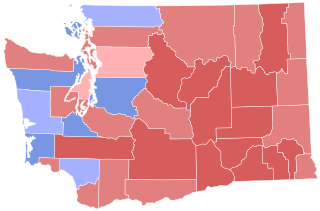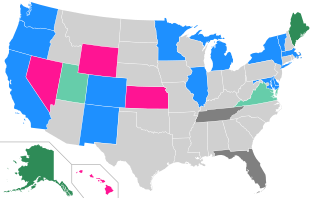Pennsylvania held statewide municipal elections on November 3, 2009, to fill a number of judicial positions and to allow judicial retention votes. [1] The necessary primary elections were held on May 19, 2009. [2]
| Elections in Pennsylvania |
|---|
 |
Pennsylvania held statewide municipal elections on November 3, 2009, to fill a number of judicial positions and to allow judicial retention votes. [1] The necessary primary elections were held on May 19, 2009. [2]
Voters were asked to fill a single vacancy on the Supreme Court of Pennsylvania. The vacant seat had been occupied by Jane Cutler Greenspan, who had agreed as a condition of her interim appointment in 2008 not to seek a full term on the court. Vying for the seat in the general election were Republican Joan Orie Melvin of Allegheny County and Democrat Jack A. Panella of Northampton County, both of whom were then serving on the Superior Court of Pennsylvania. [3] Orie Melvin won the seat with 53 percent of the vote, restoring the 4–3 Republican majority that had existed on the court prior to the 2007 state election. [4] Panella raised $2.4 million for the campaign, compared to $734,000 for Orie Melvin. [5] Low voter turnout, especially in Panella's native Philadelphia, played a key role in Orie Melvin's victory. [5]
| Party | Candidate | Votes | % | |
|---|---|---|---|---|
| Republican | Joan Orie Melvin | 946,121 | 53.3 | |
| Democratic | Jack A. Panella | 830,277 | 46.7 | |
| Total votes | 1,776,398 | 100 | ||
Four seats on the Superior Court were up for grabs. On the ballot in the general election were four Republicans, four Democrats, and one Libertarian.
Republican candidate Judy Olson won the most votes, followed by fellow Republicans Sallie Mundy and Paula Ott. There was a four-way near tie for fourth place, with Democrat Anne E. Lazarus in the lead (with 11.5% of the vote) but closely trailed by Democrat Robert J. Colville (11.4%), Republican Temp Smith (11.4%), and Democrat Kevin Francis McCarthy (11.3%). The close results triggered an optional automatic recount. While candidates Colville and McCarthy opted out of the recount, Smith declined to do so, prompting Secretary of State Pedro Cortés to order a recount to begin on November 18—the first automatic statewide recount in Pennsylvania history. [6] On December 1, the Pennsylvania Department of State announced that the recount had been completed, with the results essentially unchanged; Lazarus won the fourth seat. [7] The cost of the recount was $542,000. [8]
| Party | Candidate | Votes | % | |
|---|---|---|---|---|
| Republican | Judy Olson | 954,065 | 15.1 | |
| Republican | Sallie Mundy | 870,091 | 13.7 | |
| Republican | Paula Ott | 807,328 | 12.7 | |
| Democratic | Anne E. Lazarus | 726,917 | 11.5 | |
| Democratic | Robert J. Colville | 724,830 | 11.4 | |
| Republican | Temp Smith | 723,117 | 11.4 | |
| Democratic | Kevin Francis McCarthy | 714,237 | 11.3 | |
| Democratic | Teresa Sarmina | 690,682 | 10.9 | |
| Libertarian | Marakay J. Rogers | 127,492 | 2.0 | |
| Total votes | 6,338,759 | 100 | ||
There were two open seats on the Commonwealth Court of Pennsylvania. The Candidates in the general election were selected in the Pennsylvania Municipal Primary Election which was held May 19, 2009. The two leading Republican candidates in the Primary were Patricia A. McCullough (36.2%) and Kevin Brobson (35.9%), followed by Al Frioni (27.9%). The two leading Democratic candidates were Barbara Behrend Ernsberger (22.0%) and Linda Judson (21.1%) followed by Jimmy Lynn (15.3%) Michael Sherman (14.9%) Stephen Pollok (13.5%) and Daniel Brickmont (13.3%). [9] The General Election was held on Tuesday November 3, 2009.
| Party | Candidate | Votes | % | |
|---|---|---|---|---|
| Republican | Patricia A. McCullough | 900,666 | 28.1 | |
| Republican | Kevin Brobson | 836,511 | 26.1 | |
| Democratic | Linda S. Judson | 738,452 | 23.1 | |
| Democratic | Barbara Behrend Ernsberger | 726,431 | 22.7 | |
| Total votes | 3,202,060 | 100 | ||
Voters elected to retain Judge Kate Ford Elliott on the Superior Court.
| Choice | Votes | % |
|---|---|---|
| | 963,309 | 68.8 |
| No | 436,159 | 31.2 |
| Total votes | 1,399,468 | 100.00 |
| Source: PA Department of State | ||
Voters elected to retain Judge Dan Pellegrini on the Commonwealth Court.
| Choice | Votes | % |
|---|---|---|
| | 939,019 | 67.2 |
| No | 457,957 | 32.8 |
| Total votes | 1,396,976 | 100.00 |
| Source: PA Department of State | ||

The 2004 Washington gubernatorial election was held on November 2, 2004. The race gained national attention for its legal twists and extremely close finish, among the closest political races in United States election history. Republican Dino Rossi was declared the winner in the initial automated count and again in a subsequent automated recount, but after a second recount done by hand, Democrat Christine Gregoire took the lead by a margin of 129 votes.
A write-in candidate is a candidate whose name does not appear on the ballot but seeks election by asking voters to cast a vote for the candidate by physically writing in the person's name on the ballot. Depending on electoral law it may be possible to win an election by winning a sufficient number of such write-in votes, which count equally as if the person was formally listed on the ballot.

Elections to choose members of the North Carolina Council of State were held on Tuesday, November 2, 2004.
The Pennsylvania Republican Party (PAGOP) is the affiliate of the Republican Party in the state of Pennsylvania. It is headquartered in Harrisburg.

The results of elections in the state of New York have tended to be more Democratic-leaning than in most of the United States, with in recent decades a solid majority of Democratic voters, concentrated in New York City and some of its suburbs, including Westchester County, Rockland County and Long Island's Nassau county, and in the cities of Buffalo, Rochester, Syracuse, Albany, and Ithaca.
Joan Orie Melvin is a former justice of the Pennsylvania Supreme Court. In 2013, Melvin was convicted of several criminal counts related to her use of legislative and judicial staff to perform campaign work. She is a member of the Republican Party.

Ranked-choice voting (RCV) is a ranked voting system used in some states and cities in the United States in which voters may prioritize (rank) their choice of candidates among many, and a procedure exists to count lower ranked candidates if and after higher ranked candidates have been eliminated, usually in a succession of counting rounds. In practice, there are several ways this can be implemented and variations exist; instant-runoff voting (IRV) and single transferable vote (STV) are the general types of ranked-choice voting systems used in the United States.

One justice of the North Carolina Supreme Court and five judges of the North Carolina Court of Appeals were elected by North Carolina voters on November 2, 2010, on the same day as the U.S. Senate election, U.S. House elections, and other state-level elections. North Carolina judicial elections are non-partisan. Terms for seats on each court are eight years. All incumbent judges and justices who sought re-election won their respective races, except for Judge Cressie Thigpen of the Court of Appeals, who had been appointed shortly before the election and lost North Carolina's first statewide election to use Instant-runoff voting.

Pennsylvania held statewide elections on November 8, 2011, to fill judicial positions and allow judicial retention votes. The necessary primary elections were held on May 17, 2011.
Mary Jane Bowes is a judge of the Superior Court of Pennsylvania. She was elected in 2001 and began her term in January 2002.

Elections in Alabama are authorized under the Alabama State Constitution, which establishes elections for the state level officers, cabinet, and legislature, and the election of county-level officers, including members of school boards.

Four justices of the seven-member North Carolina Supreme Court and four judges of the 15-member North Carolina Court of Appeals were elected by North Carolina voters on November 4, 2014, concurrently with other state elections. Terms for seats on each court are eight years.

One justice of the seven-member North Carolina Supreme Court and five judges of the 15-member North Carolina Court of Appeals were elected by North Carolina voters on November 8, 2016, concurrently with other state elections. Terms for seats on each court are eight years.

Pennsylvania held statewide elections on November 3, 2015, to fill judicial positions, fill a vacancy in the Pennsylvania State Senate, allow judicial retention votes, and fill numerous county, local and municipal offices. The necessary primary elections were held on May 19, 2015.

Three justices of the seven-member North Carolina Supreme Court and five judges of the 15-member North Carolina Court of Appeals were elected by North Carolina voters on November 3, 2020, concurrently with other state elections. Terms for seats on each court are eight years. These elections were conducted on a partisan basis.

Pennsylvania held statewide elections on November 7, 2017 to fill judicial positions on the Supreme Court, Superior Court, Commonwealth Court, allow judicial retention votes, and fill numerous county, local and municipal offices. The necessary primary elections were held in May 2017.

The 2019 Pennsylvania elections was held on November 5, 2019 to fill judicial positions on the Superior Court, allow judicial retention votes, and fill numerous county, local and municipal offices, the most prominent being the Mayor of Philadelphia. The necessary primary elections were held in May 2019. In addition, special elections for legislative vacancies were held at various times in 2019.

The 2021 Pennsylvania elections were held on November 2, 2021, to fill judicial positions on the Supreme Court, Superior Court, Commonwealth Court, allow judicial retention votes, and fill numerous county, local and municipal offices. The necessary primary elections were held on May 18. In addition, special elections for legislative vacancies were held at various times in 2021.

The 2022 Arizona elections were held in the state of Arizona on November 8, 2022, coinciding with the nationwide general election. All six executive offices were up for election, as well as a U.S. Senate seat, all of the state's U.S. House of Representatives seats, and the state legislature.

The 2023 Pennsylvania elections will take place on November 7, 2023, to fill judicial positions, allow judicial retention votes, and fill numerous county, local and municipal offices, the most prominent being the Mayor of Philadelphia. The necessary primary elections will be held on May 16, 2023. In addition, special elections for legislative vacancies could be held at various times in 2023.
After all, she owes her seat on the high court largely to the incredible voter apathy displayed last Tuesday in the City of Brotherly Love.[ permanent dead link ]
The last statewide recount - in a November 2009 contest for Superior Court race - cost the state $542,000.